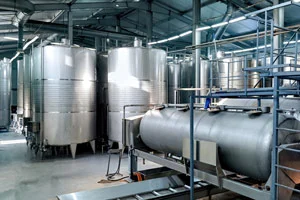Importance of gases in wine bottling
Continuing with the topic of gases during the wine bottling process, today at Agrovin we want to focus on the importance of carbon dioxide in red, rosé and white wines, and how it can be treated to ensure the proper levels in each batch.
What carbon dioxide means for wine
In oenology, Carbon dioxide is very important, as it helps control oxygen levels, protects the liquid, is largely responsible for carbonic maceration and gives freshness to the wine.
CO₂ gives white wines a specific aroma, both refreshing and with a certain very light bite.
Carbon dioxide is produced by yeasts during the natural fermentation process. It is an additive permitted by EU regulations and is also used to protect wine and must from oxygen.
For winemakers, it is essential that it be preserved, especially in whites and some rosés, where the carbon dioxide content must be higher than in red wine. This can be achieved by cold storage.
Nowadays this is not an excessive problem thanks to steel tanks, as they keep the temperature under control. If the white wine is bottled soon, the carbon dioxide produced by fermentation is hardly lost.
In the case of white wines, the amount of carbon dioxide that remains after the fermentation process is between 1.5 and 2 grams per litre.
In reds, an attempt is made to reduce the presence of CO₂ by dragging or sifting with inert gas to achieve a presence between 0.2 and 0.4 grams per litre.
Carbon gas can also be introduced artificially, remaining within the limits established by the law. Traditionally, this procedure for adding CO₂ to the wine has been carried out by cooling the wine and subjecting it to gas bubbles to enhance the youth of these wines.
What influence does carbon dioxide have on bottled wine?
CO₂ is very important for ensuring a balanced taste in still wines. This gas accentuates the perception in freshness and acidity, attenuates the sweet taste and intensifies bitterness and astringency, while producing a certain bite.
Low carbon dioxide levels in white wines leads to the perception that the wine is very flat, but an excess in the reds increases the astringency.
The truth is that professionals and winemakers can perceive different profiles depending on the concentration of carbon dioxide in the wine, so it is necessary to adjust it from the point of view of the wine’s profile and its commercial objective, but it is important to note that until the moment of bottling, it is important to preserve the level of carbon gas.
The carbon dioxide solubility conditions vary depending on three factors:
- Temperature: When the temperature increases, the solubility decreases.
- Pressure: As the pressure rises, the solubility also increases.
- Composition of the wine: The carbon dioxide can be combined with other components present in the wine, which influences the solubility of the gas.
What is its organoleptic influence?
Carbon dioxide affects our senses in two major ways:
- It has a slightly acidic taste, perceptible in water starting at 200 mg/l.
- At higher concentrations, when released, it exerts a tactile sensation of tingling or bite on the surface of the mucous membranes of the mouth.
In wine, it is only perceived above 500 mg/l. In lower concentrations, it is not detectable but it does not stop exerting a clear influence on the wine’s balance.
Below the perception threshold, the gas acts as an acidulant in the wine. Fr. Ribéreau-Gayon observed that tasters are more sensitive to variations in carbonic acidity than to the acidity of wine itself.
By acting as an acidulant, adding to the acidic impression, it directly influences the balance of the wine’s flavors as an acidification would, reinforcing the imbalance in acidic and hard wines, increasing the feeling of astringency and greenness (enhancing the most aggressive and drying tannins) and thins wines that would otherwise be balanced. On the other hand, it brings liveliness and freshness to soft or flat wines.
Moreover, the evaporation of the gas in the cup when shaking helps release more odour. Thus, the fruity aroma of young wines is strengthened and enlivened; while the bouquet of slightly gaseous older wines appears denatured by those acidic nuances.
What level of CO₂ is appropriate?
The appropriate levels of dissolved CO2 differ according to the characteristics of the wine. In red wines, high levels of carbon should be avoided, lower levels are recommended the more the wine is aged:
- Young wines between 400–500 mg/l CO2
- Carbonic maceration wines is slightly higher at 750–800 mg/l
- Wines to be aged in bottle should not exceed 200 mg/l
CO2 and malolactic characters don’t go well together.
In white wines, it will also depend on the type of wine:
- Wines where volume predominates in the mouth, Chardonnay, aging on lees, aging in oak, between 500 and 750 mg/l.
- Especially fruity wines, Sauvignon blanc, verdejo… between 1000-1100 mg/l
- Wines with residual sugar >15 g/l between 1000-1400 mg/l
Bottling pressure
There is a safety aspect to bottling. Cap manufacturers’ specifications typically suggest that dissolved CO2 levels remain below 1.2 g/l of 2 g/l depending on the bottle. Above 1.5 grams per liter, the gas tends to expel the stoppers from bottled wines.
The potential impact of high CO2 levels from bag-in-box packaging. Above 600–800 mg/l, the bag may swell when the temperature rises and CO2 leaves the solution. This swelling could be confused with a refermentation.
As for screw caps, practically no CO2 escapes, so a bottle of wine at 1.2 g/l will stay that way. With 1.2 or 1.1 g/l in cork bottles, in general after the shipment of a wine, 100–150 mg is lost during the first 4–6 weeks, depending on the quality of the closure, the diameter of the bottle, temperature, etc., so there will be no excess bite.


